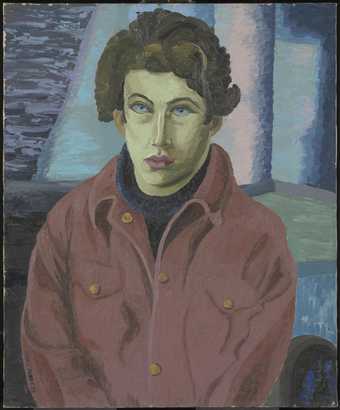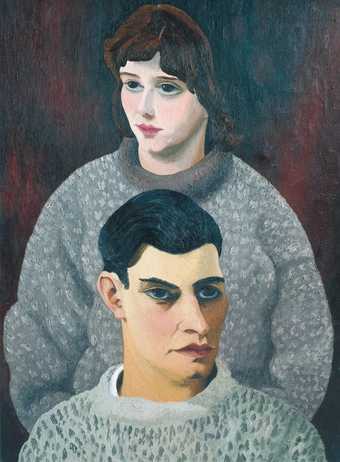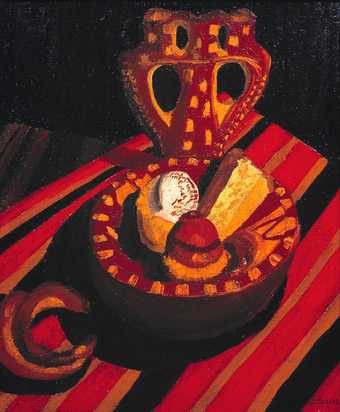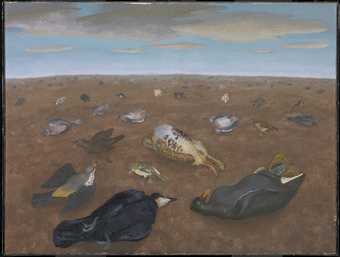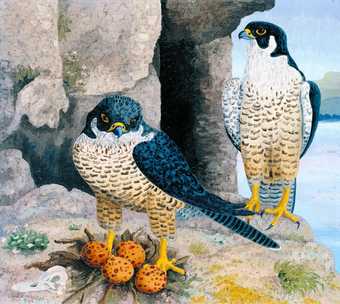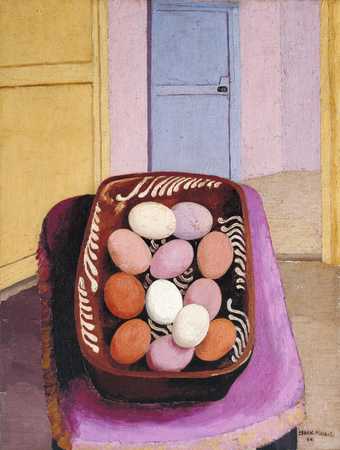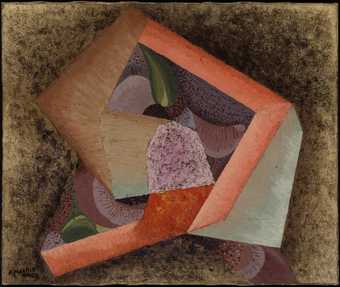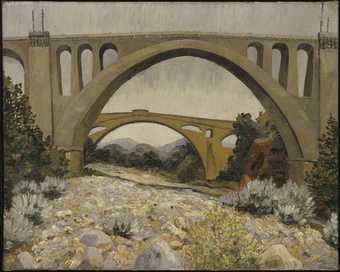
Not on display
- Artist
- Sir Cedric Morris, Bt 1889–1982
- Medium
- Oil paint on canvas
- Dimensions
- Support: 1219 × 918 mm
frame: 1415 × 1101 × 70 mm - Collection
- Tate
- Acquisition
- Purchased 1981
- Reference
- T03230
Display caption
Gallery label, February 2004
Does this text contain inaccurate information or language that you feel we should improve or change? We would like to hear from you.
Catalogue entry
T03230 IRIS SEEDLINGS 1943
Inscribed ‘CEDRIC MORRIS/-43’ bottom right
Oil on canvas, 48 × 36 1/2 (122 × 91.7)
Purchased from Brian Sayers (Grant-in-Aid) 1981
Prov:
Purchased from the artist by Mrs Edmund (later Lady) Leach; Brian Sayers 1978
Exh: Paintings by Sir Cedric Morris, Bury St Edmunds Art Gallery, November–December 1978 (37) as ‘Irises’, and with dimensions reversed; Cedric Morris, Tate Gallery, March–May 1984 (79, repr.in colour), and tour to Barnard Castle, Cardiff and Colchester
Lit: Christopher Neve and Tony Venison, ‘A Painter and his Garden: Cedric Morris at Benton End’, Country Life, 17 May 1979, pp.1532–34
Cedric Morris was well-known both as a painter and as a gardener. In the latter field his greatest fame was as a breeder of irises. In 1949 he received the Foster Memorial Plaque, the highest award made by the British Iris Society to individuals who have made special contributions to the Genus Iris. His Benton Cordelia is the only variety to have received the Society's Silver medal at its first showing.
In his article ‘Concerning Plicatas’ in the Iris Year Book 1943, pp.43–5, Morris wrote ‘Being a painter by trade, my judgement and bias is rather that of painter than of plant breeder.’ In conversation with the compiler in June 1981 he said that of the two activities painting was ultimately more important to him than gardening, but that the two were complementary.
Morris started to breed irises in 1934. In 1940, an important year in the history of his breeding (as explained in his Iris year Book article of 1943) he moved to Benton End, a large unoccupied house at Hadleigh, Suffolk, going back to the sixteenth century and with extensive walled gardens which were completely overgrown. He told the compiler that he had visited the garden at Giverny, created by Monet who was almost his favourite painter, though the two did not meet. He determined to make at Benton End a garden which should be used by young painters. This quickly occurred, as Benton End was not only Morris's home but the second and final location of the East Anglian School of Painting and Drawing which Morris ran, with his companion the painter Lett Haines, until the 1970s. Thus in 1940, as recounted by Neve and Venison (loc.cit.) ‘an extraordinary episode began in which a highly personal kind of painting continued to develop in conjunction with an experiment in gardening and plantmanship. And, as with his friend John Nash at Wormingford not far away, Morris's own plants were to be among his most persistent sitters...For many years the extensive lower garden at Benton End was entirely of irises...In the 1940s...the garden held about 1,000 of his new iris seedlings every year’.
Morris told the compiler that the Tate's picture was painted at Benton End both from observation and from long insight. He placed the flowers himself and in this work was particularly strongly interested in the painting's design. At the height of the iris season, things were always extremely busy, the more so because he would sometimes have more than one painting of irises in progress at the same time. These pictures were usually painted very fast, therefore. He would establish the scheme quickly and more or less finish a picture before the irises died. The jug was Chinese, and the motif behind the flowers was not a view through a window but a landscape painting by himself (not identified).
The irises in the Tate's painting are white, pink, blue, yellow and purple. In his 1943 article Morris noted that that year had produced his best seedlings yet, and that ‘all are the result of close in-breeding and selfing of my own stock, that is to say, of at least two generations, and all are plicatas both ways’. He gives detailed information on the irises from which he bred, and on the results. N. Leslie Cave, ‘The Iris of Cedric Morris’, in American Iris Society Bulletin, 1945 pp.78–82 amplifies this information with descriptions of eleven named irises which Morris had bred, each with ‘Benton’ as the first word of its name. The word ‘seedlings’ in the title of the Tate's picture was given by Morris before and confirmed by him after the Tate's purchase of the work. Dr Bernard Verdcourt, of the Royal Botanic Gardens, Kew, writes that he would describe the subject as ‘Bearded Iris Hybrids’. Miss Jenny Robinson writes (letter, 7 December 1982) that the painting represents ‘the first flowers (implied by the word seedlings) from a line of hybridisation that he had been working on’, adding that ‘iris hybridisation has developed at such a pace that those grown in 1943 have long been overtaken...Indeed I think the picture has quite a historical significance as it probably shows the ancestors of the irises with which Cedric hit the jack-pot a few years later’.
Morris told the compiler that he painted at least twenty pictures of irises. In the article of 1945 already mentioned, Leslie Cave reported that he was in the habit of painting his irises each year. He continued to paint irises at least until 1972 when at the commission of the Species Group of the British Iris Society he painted the small oil of onco-cyclus irises which is the Angela Marchant Trophy, awarded annually to the best species exhibit at the Society's Summer Show.
In his article ‘Concerning Flower Painting’ in Studio, CXXIII, 1942, pp.121–132, Morris characterised various flowers in words, referring to ‘the elegance, pride and delicacy of irises’. He wrote that ‘the aspect of belles et jolies fleures, or charming, gay, lovely, etc., mean no more to me than such qualities do in natural reaction to life in general; it is more the attributes of grimness, ruthlessness, lust and arrogance that I find, and above all, the absence of fear in their kingdom’. He urged a detailed understanding by the artist of the life of the plants he depicts, praising Chinese flower painters because the artist knew and understood his subject ‘and therefore it became part of him’. He wrote that the painter ‘must get across something as well of the esoteric meaning of plants. This might be called “vision” and reality, as opposed to realism. Reality is knowledge and realism is only the appearance of knowledge’. He distinguished between ‘flower painting and a good painting of flowers; the former being painted by one who loved and therefore comprehended flowers and the latter by any good painter who happened to choose flowers as one of his subjects much as he might any other still life. In this direction of artistic achievement, intimacy with the subject is equal in importance with observance of the pictorial qualities: in other words, the painterly values alone are insufficient. Perhaps it is modesty we lack in recent European painting - I am sure that only a modest man can paint a flower’.
Published in:
The Tate Gallery 1980-82: Illustrated Catalogue of Acquisitions, London 1984
Explore
- objects(23,571)
- vessels and containers(2,157)
-
- jug(228)
You might like
-
Sir Cedric Morris, Bt Lucian Freud
1941 -
Sir Cedric Morris, Bt David and Barbara Carr
c.1940 -
Sir Cedric Morris, Bt Patisseries and a Croissant
c.1922 -
Sir Cedric Morris, Bt Landscape of Shame
c.1960 -
Sir Cedric Morris, Bt Peregrine Falcons
1942 -
Sir Cedric Morris, Bt Belle of Bloomsbury
1948 -
Sir Cedric Morris, Bt The Eggs
1944 -
Sir Cedric Morris, Bt Experiment in Textures
1923 -
Sir Cedric Morris, Bt Les Ponts de Ceret
1923

